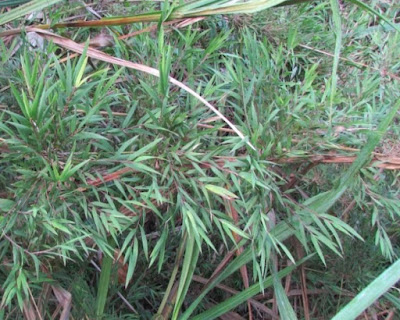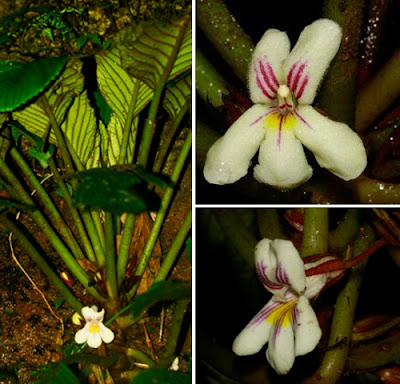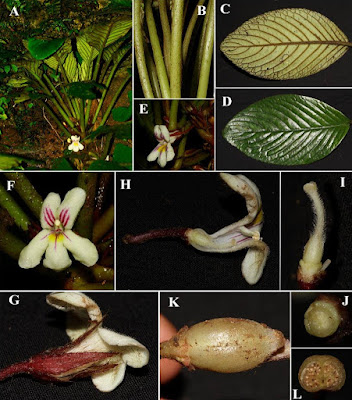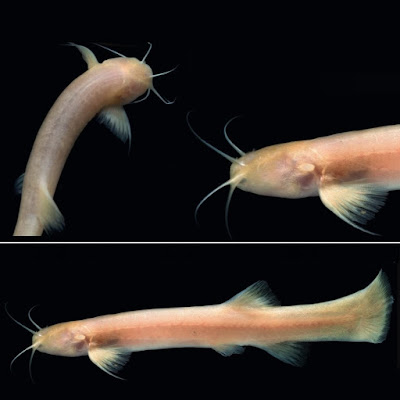[Most Recent Entries] [Calendar View]
Thursday, August 16th, 2018
| Time | Event | ||
| 9:10a | [Botany • 2018] Chusquea gouveiensis (Poaceae, Bambusoideae) • A New Species of Chusquea subg. Chusquea from Minas Gerais, Brazil: Morphological Evidence and Phylogenetic Placement within the Euchusquea clade Abstract Chusquea gouveiensis is a new species of tropical woody bamboo from Brazil, herein described and illustrated. It is classified within C. subg. Chusquea, mainly based on its scandent habit, triangular central bud with vertical orientation, extra-or infravaginal branching, and lemma margins free at the apex. The new species is most similar to C. gracilis because they share culm leaves with undifferentiated sheaths and blades with a folded or twisted apex, and foliage leaves and spikelets of similar length. However, C. gouveiensis is distinguished from C. gracilis by having branch complements of 40‒90 usually ascending subsidiary branches (vs. 70‒195 mostly horizontally oriented subsidiary branches), synflorescences weakly paniculate to racemose (vs. paniculate), glumes I and II collectively 0.3‒0.7 mm long (vs. 0.1‒0.2 mm long), and glumes III and IV awned and abaxially pilose to pubescent at the apex (vs. mucronate and glabrous). The two species also differ in distribution: C. gouveiensis is only known from the region of Gouveia and Diamantina, in the southern portion of the Espinhaço Range in Minas Gerais state, Brazil, in forest fragments at 1,200‒1,300 m.a.s.l., whereas C. gracilis occurs in the southern Brazilian states of Paraná, Santa Catarina and Rio Grande do Sul, in mixed ombrophilous forests between 550 and 880 m.a.s.l. Based on nuclear internal transcribed spacer (ITS) and plastid DNA sequence data (ndhF and trnD-trnT), a sixth lineage within the Euchusquea clade was identified, herein named clade VI—Chusquea meyeriana clade, comprising a significant portion of the Brazilian species of Chusquea. The new species has phylogenetic affinities with the C. meyeriana informal group and is also distinct from C. gracilis in the phylogeny. Keywords: Monocots, Chusqueinae, Espinhaço Range, molecular evidence, taxonomy, woody bamboos Kaio Vinicius de Araújo Vidal, Cassiano A. Dorneles Welker, Iasmin Laiane de Castro Oliveira, Aline Costa da Mota, Reyjane P. Oliveira and Lynn G. Clark. 2018. A New Species of Chusquea subg. Chusquea (Poaceae—Bambusoideae—Bambuseae) from Minas Gerais, Brazil: Morphological Evidence and Phylogenetic Placement within the Euchusquea clade. Phytotaxa. 365(1); 73–88. DOI: 10.11646/phytotaxa.365.1.3 | ||
| 9:43a | [Botany • 2016] Billolivia cadamensis (Gesneriaceae) • A New Species from central Vietnam ABSTRACT A new species, Billolivia cadamensis Q. D. Nguyen, N. L. Vu & H. T. Luu, sp. n. of the family Gesneriaceae is described from Quang Ngai Province, central Vietnam. The new taxon is close to B. tichii but differs in shorter stem, abaxially glabrous bracts, calyx divided into 5 lobes to base, outside pubescent apical half of corolla tube, oblong or deltoid corolla lobes, dense hairs on apical 3/4 of the ovary and white corolla lobes. A key to all already known species from Billolivia of Vietnam is given. Keywords: Gesneriaceae, Billolivia, new species, Vietnam. Billolivia cadamensis Q. D. Nguyen, N. L. Vu & H. T. Luu, sp. n. Allied to B. tichii in general appearance but different in having much shorter stem, glabrous bracts, calyx divided into 5 lobes to base, outside pubescent apical half of corolla tube, oblong or deltoid corolla lobes, dense hairs on apical 3/4 of the ovary and white corolla lobes. Etymology: Named after the location (Ca Dam Mountain) where the new species was found. Proposed Vietnamese name: Lưu hoa cà đam. Nguyen Quoc Dat, Dinh Nhat Lam, Nguyen Hieu Cuong, Vu Ngoc Long and Luu Hong Truong. 2016. Billolivia cadamensis (Gesneriaceae), A New Species from central Vietnam. Tap chi Sinh hoc. 38(4); 492-496. DOI: 10.15625/0866-7160/v38n4.8837 | ||
| 9:55a | [Ichthyology • 2018] Trichomycterus rosablanca • A New Species of Hipogean Catfish (Siluriformes, Trichomycteridae) from the Colombian Andes Abstract Trichomycterus rosablanca is described as a new troglobitic catfish species from caves in southeastern Santander, Colombia. These caves are drained by the Carare River of the Magdalena River basin. The new species is characterized by the advanced condition in the typical troglomorphisms found in other congeneric cave-dwelling species, such as absence of eyes and pigmentation. Trichomycterus rosablanca is diagnosed by the following putative autapomorphies: 1) presence of a circular foramen in the main body of the interopercle, dorsal to the interopercular plate supporting the odontodes, and 2) presence of a single sensory pore in the posteriormost section of the infraorbital canal. Trichomycterus rosablanca can be distinguished from all known Trichomycterus species from Colombia by having the supraorbital canal interrupted in the nasal section, resulting in the pattern of s1, s2, s3, and s6 sensory pores, and the lachrimal/antorbital bone not enclosing the anteriormost section of the infraorbital canal. The genetic distinctiveness of Trichomycterus rosablanca is confirmed by GMYC and genetic distance method analyses of the cytochrome C oxidase subunit I gene sequence. The description of this species places Colombia as the second most diverse country in the continent in terms of number of cave fish species and calls the attention on the conservation efforts needed to guarantee the permanence of this remarkable diversity of hypogean fishes. Keywords: Cave fish. Karstic. Middle Magdalena River basin. Santander.
Trichomycterus rosablanca, new species Etymology. The specific name is used as a noun in apposition in reference to the Rosablanca karstic formation where the type locality is found. Lina M. Mesa S., Carlos A. Lasso, Luz E. Ochoa and Carlos DoNascimiento. 2018. Trichomycterus rosablanca (Siluriformes, Trichomycteridae) A New Species of Hipogean Catfish from the Colombian Andes [Trichomycterus rosablanca (Siluriformes, Trichomycteridae) una especie nueva de bagre hipogeo de los Andes colombianos]. Biota Colombiana. 19 (Sup. 1); 95-116. DOI: 10.21068/c2018.v19s1a09 Resumen: Se describe Trichomycterus rosablanca, una especie nueva de bagre troglobio de cuevas en el suroriente de Santander, Colombia. Estas cuevas son drenadas por el río Carare, de la cuenca del río Magdalena. La especie nueva se caracteriza por la condición avanzada en los troglomorfismos típicos encontrados en otros congéneres habitantes de cuevas, como ausencia de ojos y pigmentación. Trichomycterus rosablancaes diagnosticado por las siguientes autapomorfías putativas: 1) presencia de un foramen circular en el cuerpo principal del interopérculo, dorsal a la placa interopercular soportando los odontodes, y 2) presencia de un único poro sensorial en la sección más posterior del canal infraorbital. Trichomycterus rosablanca puede ser distinguida de todas las especies conocidas de Trichomycterus de Colombia por tener el canal supraorbital interrumpido en la sección nasal, resultando en el patrón de poros sensoriales s1, s2, s3 y s6 y el hueso lacrimal/antorbital no encerrando la sección más anterior del canal infraorbital. La identidad genética de Trichomycterus rosablanca es confirmada por análisis GMYC y de distancia genética de la secuencia génica de la subunidad I de la citocromo C oxidasa. La descripción de esta especie ubica a Colombia como el segundo país más diverso en el continente en términos del número de especies de peces cavernícolas y llama la atención sobre los esfuerzos de conservación necesarios para garantizar la permanencia de esta extraordinaria diversidad de peces hipogeos. Palabras clave: Cárstico. Cuenca media del río Magdalena. Pez cavernícola. Santander. |
| << Previous Day |
2018/08/16 [Calendar] |
Next Day >> |













